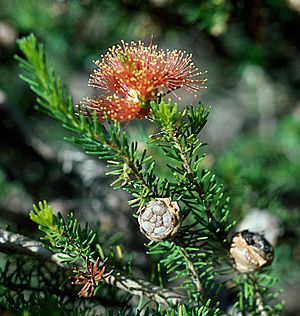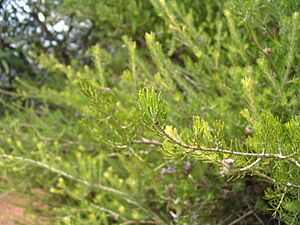Eremaea ebracteata facts for kids
Quick facts for kids Eremaea ebracteata |
|
|---|---|
 |
|
| Eremaea ebracteata in Kings Park, Perth | |
| Scientific classification | |
| Genus: |
Eremaea (plant)
|
| Species: |
ebracteata
|
| Synonyms | |
|
Melaleuca ebracteata (F.Muell.) Craven & R.D.Edwards |
|
Eremaea ebracteata is a special plant that belongs to the myrtle family, called Myrtaceae. This plant is endemic, which means it grows naturally only in one place: the south-west region of Western Australia. It's a shrub with narrow, mostly straight leaves. You can spot it by its bright orange flowers that grow on the long branches that grew in the same year. When the flowers are gone, they leave behind fruits that feel rough and lumpy.
Contents
About This Plant
Eremaea ebracteata is a shrub that can grow up to about 1.0 metre (3 ft) tall. Its younger branches are covered with many fine hairs. The leaves are usually long and thin, but some can be shaped like a wide egg, with the narrower part at the bottom. They are about 2.5–8.2 millimetres (0.1–0.3 in) long and 0.5–1.7 millimetres (0.02–0.07 in) wide. You can often see one clear vein on the underside of the leaf. (There are two slightly different types of this plant, mainly recognized by their leaf size and shape.)
The flowers of Eremaea ebracteata are a vibrant orange color. They grow at the ends of long branches that have grown earlier in the same season. Usually, you'll see one flower, but sometimes two or three might grow together. Each flower has 5 sepals (small, leaf-like parts that protect the bud) that are hairy on the outside. It also has 5 petals, which are about 5.4–6.7 millimetres (0.2–0.3 in) long. Inside the flower, the stamens (the parts that produce pollen) are grouped into 5 bundles, with each bundle holding 40 to 60 stamens!
This plant usually flowers from November to December. After the flowers bloom, they turn into woody capsules, which are like small seed pods. These capsules are about 5.8–8.4 millimetres (0.2–0.3 in) long and 5.7–9.5 millimetres (0.2–0.4 in) wide. They are shaped like a cup or are almost round, and their outer surface feels rough or lumpy.
How This Plant Got Its Name
The plant Eremaea ebracteata was first officially described in 1860 by a scientist named Ferdinand von Mueller. He wrote about it in his book, Fragmenta Phytographiae Australiae. The second part of its scientific name, ebracteata, comes from two Latin words. The prefix e means "without," and bracteatus means "gilt" or "decorated." So, the name hints at a feature of the plant.
There are two slightly different types, or varieties, of Eremaea ebracteata:
- Eremaea ebracteata var. ebracteata: This type has long, thin leaves that are about 4.5–8.2 millimetres (0.2–0.3 in) long and 0.5–1.0 millimetre (0.02–0.04 in) wide.
- Eremaea ebracteata var. brachyphylla: This type has leaves that are more oval or egg-shaped. They are shorter, about 2.5–3.1 millimetres (0.098–0.12 in) long, and a bit wider, about 1.3–1.7 millimetres (0.05–0.07 in) wide.
Where Does It Grow?
Eremaea ebracteata is found in an area of Western Australia called the Irwin district. The first variety, ebracteata, usually grows more in the northern parts of this region. This plant likes to grow in sandy soil or soil that is a mix of sand and loam, often on flat, sandy areas called sandplains.
Protecting the Eremaea ebracteata
Good news! Both varieties of Eremaea ebracteata are considered "not threatened" by the Western Australian Government's Department of Parks and Wildlife. This means they are not currently at risk of disappearing.


